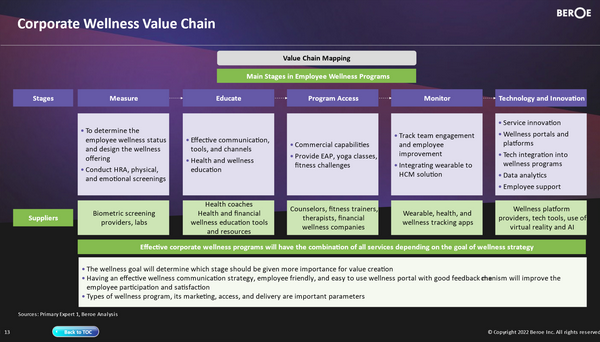The global Corporate Wellness market is forecasted to grow to above $80 billion at a percentage of around 6.8 by 2026This year, a holistic approach toward wellness solutions and an urge in mental wellness will be seen due to the increase in Hybrid Work-Culture.
Virtual Assistance programs and a lot of health Applications are witnessing high growth as an effect of Post Pandemic and Remote Workforce.
Value Chain: Corporate Wellness 
Corporate Wellness Market Outlook
Wellness Programs are one of the top priorities among the buyers now for employee retention and recruiting new ones. The demand for holistic wellness programs and mental wellness faced a surge due to hybrid work culture. The US has the highest market maturity followed by Europe. APAC and MEA are slowly growing for wellness services.
The demand for holistic wellbeing solution is driving the North American and the European Markets, whereas Employee Assistance and fitness programs are gaining importance in the APAC region.
- Employers are supporting holistic wellness covering work from home issues, nutrition and social wellbeing programs. They are also trying toengage with telehealth providers that can offer EAP solutions having mindfulness apps for a health life that’s growing in APAC regions.
The supply market in the developed region is launching innovation solutions, also governments across all the major countries are promoting the use of telehealth.
Hiring a wellness vendor is going to be more expensive than buying a wellness platform, around 0% difference. Cost of procuring wellness service is overall going to be higher, with increased costs such as screening, mental health, onsite fitness solutions, health checks etc.
Among all the end users, large scale organisation segment has the highest Market share in the Global Corporate Wellness Market. North America has the highest Wellness Adoption rate.
Corporate Wellness Market is seen rising over past 3 years with many service providers coming up with new plans and bundled services to have an efficient business outcome.
Global Corporate Wellness Industry Trends
Increasing levels of employee wellness globally, signals the increasing buyer maturity and the willingness to partner with the suppliers. Therefore, suppliers are also coming up with innovative solutions like providing health screenings, lifestyle management and disease management programs.
Multinational firms in EMEA and APAC are concentrating on improving the working conditions and offering annual health check-ups.
Buyers spend around 10-20% of their total workplace wellness expenditures on technology to yield better employee engagement thereby increasing employee participation. Companies are using technology suppliers (Virtual and Augmented Reality) to help solve mental health problems Eg- Psious, Clevr.
The demand for virtual EAPs have gone high as new health apps are bringing in new features to support mental as well as emotional health crisis.
Primary health care provider shave started to include mental health resources and EAP services in their Service line capabilities.
Corporate Health and Wellness Pricing Insights
Technology advancements in the wellness space, digital apps and virtual solutions will have a small increase in cost in the initial set up of wellness programs.
The per employee-based pricing model is shifting to the outcome-based model so as to understand the return on investment and preferably go for a more cost effective but an effective program.
The pricing mechanism for outsourcing benefit administration is evolving because of increased buyer maturity. Buyers are demanding outcome-based pricing to derive more value from the participation rather than looking for cost savings from cost arbitrage.
Corporate Health and Wellness Supply Outlook
Virtual wellness solutions or EAPs have gained attention of end users because of its ease to access, reduced wait times, user experience, quality care and follow-ups.
Supplier market in the developed regions have started including innovative solutions in promoting wellbeing of the individual. There have been a lot of supplier acquisitions happening in wellness and EAP space to improve the supplier positioning in global service capability and digital health capability
Increase in acquisition of suppliers:
TELUS health acquires lifeworks.
ICAS got acquired by Lyra Health
Regional Market Insights
Most of the global service providers have their presence in North America. Around 90% of employees in NA and 40% in Europe has access to workplace wellness programs. APAC and Latin America are slowly witnessing an increase in adoption as it is seen that large global players are to consolidate supply base.
Due to the presence of emerging and growing markets like Australia, China and India, the maturity of the Buyers is expected to increase over the coming years.
Supplier Intelligence
The category intelligence provides insights on key global and regional players such as Optum, Lifeworks, ComPsych, Workplace options, ICAS (Lyra Health), Virgin Pulse, Fitbit Inc and Optima Health among others.
Wellness Programs’ growth will be mainly decided by its ability to help clients with employee engagement and reduce absenteeism. Service providers have started providing features like online ergonomic advice, assessments, and consulting to remote employees, chatbots and virtual assistance. Several major service providers are tying up with Regional and local providers to leverage their services








